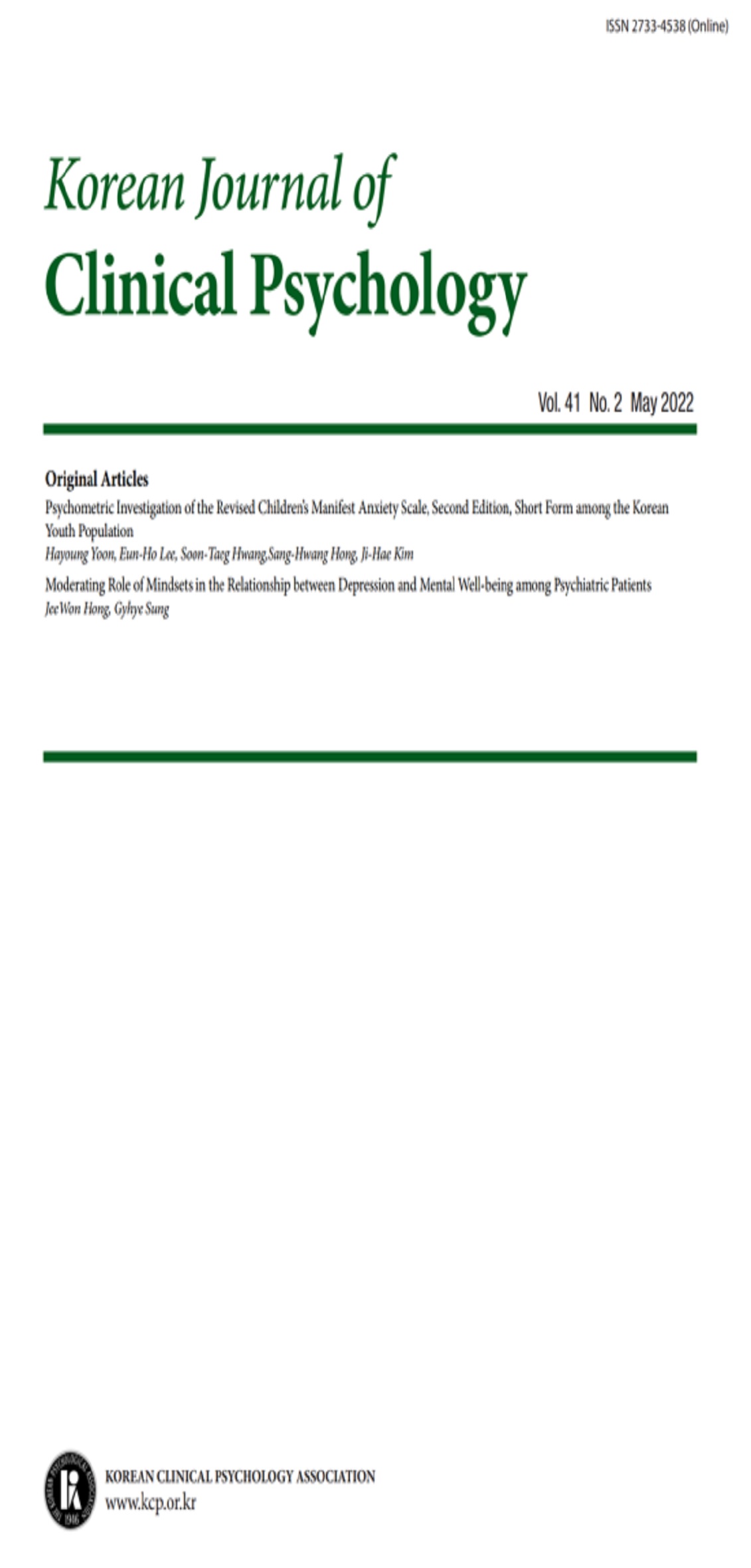open access
메뉴
open access
메뉴 E-ISSN : 2733-4538
E-ISSN : 2733-4538
본 연구에서는 외현적 내현적 자기애 특성, 즉 웅대성과 취약성을 모두 보이는 자기애자들이 긍정적 부정적 자기관련 정보에 대해 지각적 정보처리 수준에서 민감성을 보이는지 여부를 검증하였다. 대학생 403명에게 자기애적 성격장애 척도를 실시하여 점수에 따라 상, 중, 하 집단 각 13명을 대상으로 범주판단과제를 시행하였다. 결과 자기애자들은 부정적 자기관련 형용사가 방해자극으로 제시될 때 긍정적 혹은 중성적 형용사 조건에서보다 범주판단이 오래 걸렸다. 이는 부정적 자기관련 자극에 자기애자들이 지각적으로 민감함을 의미하였다.
This study investigated the perceptual sensitivity to positive and negative self-relevant information in narcissists who demonstrated both overt (i.e., grandiosity) and covert (i.e., fragility) narcissistic tendencies. Four hundred and three Korean undergraduates completed the Narcissistic Personality Disorder Scale (NPDS; Hwang, 1995). Thirteen students who scored high, average, and low on the NPDS were recruited as high narcissists, average, and low narcissists, respectively. The 39 participants performed a category judgment task that required them to categorize either clothing or reading material related to a noun which was presented for 500 msec on the computer screen, while ignoring a simultaneously presented adjective. The distracting adjectives were either positive self‐relevant, negative self‐relevant, or neutral. Results indicated that high narcissists exhibited extended category judgment time when negative self-relevant adjectives were presented as distracters. This indicated narcissists’ attention was captured by negative adjectives, thereby demonstrating perceptual sensitivity to negative self-relevant information in narcissists.
강선희, 정남운 (2002). 내현적 자기애 척도의 개발 및 타당화 연구. 한국심리학회지: 상담 및 심리치료, 14(4), 969-990.
강은영, 이영호 (2006). 이차원 자기애 척도의 개발과 타당화: 자기주도적 자기애 및 타인의존적 자기애와 심리적 특성과의 관계. 한국심리학회지: 임상, 25(2), 397-415.
연세대학교 언어정보개발연구원. (1998). 현대 한국어의 어휘 빈도. 연세대학교 언어정보개발연구원 내부보고서.
이관용 (1991). 우리말 범주규준 조사. 한국심리학회지: 실험 및 인지, 3, 131-160.
황순택 (1995). 전형성 평정에 의한 성격장애 진단준거 개발. 연세대학교 대학원 박사학위 청구논문.
Akhtar, S., & Thompson, A. (1982). Overview: Narcissistic personality disorder. American Journal of Psychiatry, 139, 12-20.
American Psychiatric Association (1994). Diagnostic and Statistical Manual of Mental Disorders (3rd ed, revised). Washington, DC: Author.
Atlas, G. D., & Them, M. A. (2008). Narcissism and sensitivity to criticism: A preliminary investigation. Current Psychology, 27, 62-76.
Besser, A., & Zeigler-Hill, V. (2010). The influence of pathological narcissism on emotional and motivational responses to negative events: The roles of visibility and concern about humiliation. Journal of Research in Personality, 44, 520-534.
Bosson, J. K., Lakey, C. E., Campbell, W. K., Zeigler-Hill, V., Jordan, C. H., & Kernis, M. H. (2008). Untangling the links between narcissism and self-esteem: A theoretical and empirical review. Social and Personality Psychology Compass, 2, 1415-1439.
Farwell, L., & Wohlwend-Lloyd, R. (1998). Narcissistic processes: Optimistic expectations, favorable self-evaluations, and self-enhancing attributions. Journal of Personality, 66(1), 64-83.
Gregg, A. P., & Sedikides, C. (2010). Narcissistic fragility: Rethinking its links to explicit and implicit self-esteem. Self and Identity, 9, 142-161.
Hartouni, Z. S. (1992). Effects of narcissistic personality organization on causal attributions. Psychological Reports, 71, 1339-1346.
Hendin, H. M., & Cheek, J. M. (1997). Assessing hypersensitive narcissism: A reexamination of Murray’s narcism scale. Journal of Research in Personality, 31, 588-599.
Kernberg, O. F. (1975). Borderline conditions and pathological narcissism. New York: Aronson.
Kernis, M. H., & Sun, C. R. (1994). Narcissism and reactions to interpersonal feedback. Journal of Research in Personality, 28, 4-13.
Kohut, H. (1977). The restoration of the self. New York: International Universities Press.
Ladd, E. R., Welsh, M. C., Vitulli, W. F., Labbe, E. E., & Law, J. G. (1997). Narcissism and causal attribution. Psychological Reports, 80, 171-178.
Morf, C. C., & Rhodewalt, F. (2001). Unraveling the paradoxes of narcissism: A dynamic self-regulatory processing model. Psychological Inquiry, 12(4), 177-196.
Reich, W. (1960). Pathological forms of self-esteem regulation. Psychoanalytic Study of the Child, 15, 215-232.
Rhodewalt, F., & Morf, C. C. (1995). Self and interpersonal correlates of the Narcissistic Personality Inventory: A review and new
Rhodewalt, F., & Morf, C. C. (1998). On self-aggrandizement and anger: A temporal analysis of narcissism and affective reactions to success and failure. Journal of Personality and Social Psychology, 74(3), 672-685.
Wink, P. (1991). Two faces of narcissism. Journal of Personality and Social psychology, 61(4), 590-597.
